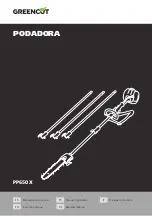
13
Stopper arm
Fig.10
The lower limit position of the blade can be easily
adjusted with the stopper arm. To adjust it, move the
stopper arm in the direction of the arrow as shown in the
figure. Adjust the adjusting screw so that the blade
stops at the desired position when lowering the handle
fully.
Adjusting the miter angle
Fig.11
Loosen the grip by turning counterclockwise. Turn the
turn base while pressing down the lock lever. When you
have moved the grip to the position where the pointer
points to the desired angle on the miter scale, securely
tighten the grip clockwise.
CAUTION:
•
After changing the miter angle, always secure the
turn base by tightening the grip firmly.
NOTICE:
•
When turning the turn base, be sure to raise the
handle fully.
Adjusting the bevel angle
Fig.12
To adjust the bevel angle, loosen the lever at the rear of
the tool counterclockwise. Unlock the arm by pushing
the handle somewhat strongly in the direction that you
intend to tilt the saw blade.
NOTE:
•
Lever can be adjusted to a different lever angle by
removing the screw holding the lever and securing
the lever at a desired angle.
Fig.13
Tilt the saw blade until the pointer points to the desired
angle on the bevel scale. Then tighten the lever
clockwise firmly to secure the arm.
Fig.14
To tilt the saw blade to right 5
゚
or left 48
゚
: set the saw
blade to 0
゚
for right 5
゚
, or 45
゚
for left 48
゚
. Then
slightly tilt the saw blade to the opposite side. Push the
release button and tilt the saw blade to the desired
position. Tighten the lever to secure the arm.
CAUTION:
•
After changing the bevel angle, always secure the
arm by tightening the lever clockwise.
NOTICE:
•
When tilting the saw blade be sure the handle is
fully raised.
•
When changing bevel angles, be sure to position
the kerf boards appropriately as explained in the
"Positioning kerf boards" section.
Slide lock adjustment
Fig.15
To lock the slide pole, turn the locking screw clockwise.
Switch action
For European countries
Fig.16
To prevent the switch trigger from being accidentally
pulled, a lock-off button is provided. To start the tool,
push the lever to the left, press in the lock-off button and
then pull the switch trigger. Release the switch trigger to
stop.
WARNING:
•
Before plugging in the tool, always check to
see that the switch trigger actuates properly
and returns to the "OFF" position when
released. Do not pull the switch trigger hard
without pressing in the lock-off button. This
can cause switch breakage.
Operating a tool
with a switch that does not actuate properly can
lead to loss of control and serious personal injury.
A hole is provided in the switch trigger for insertion of
padlock to lock the tool off.
For all countries other than European countries
Fig.17
To prevent the switch trigger from being accidentally
pulled, a lock-off button is provided. To start the tool,
press in the lock-off button and pull the switch trigger.
Release the switch trigger to stop.
WARNING:
•
Before plugging in the tool, always check to
see that the switch trigger actuates properly
and returns to the "OFF" position when
released. Do not pull the switch trigger hard
without pressing in the lock-off button. This
can cause switch breakage.
Operating a tool
with a switch that does not actuate properly can
lead to loss of control and serious personal injury.
A hole is provided in the switch trigger for insertion of
padlock to lock the tool off.
WARNING:
•
Do not use a lock with a shank or cable any
smaller than 6.35 mm in diameter.
A smaller
shank or cable may not properly lock the tool in
the off position and unintentional operation may
occur resulting in serious personal injury.
•
NEVER use tool without a fully operative
switch trigger.
Any tool with an inoperative switch
is HIGHLY DANGEROUS and must be repaired
before further usage or serious personal injury
may occur.
•
For your safety, this tool is equipped with a lock-off
button which prevents the tool from unintended
starting. NEVER use the tool if it runs when you














































